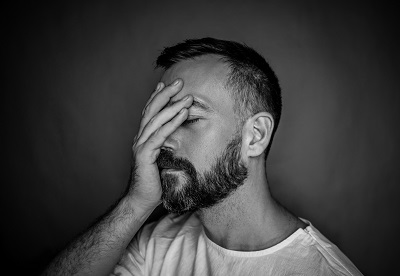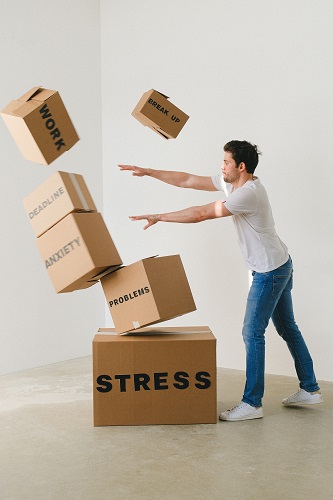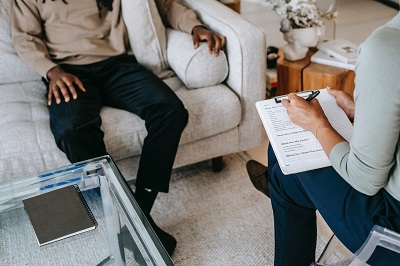Contents
It is a bit difficult to Diagnose and treat anxiety as the exact cause is unknown. Several factors, such as genetic factors, environmental factors, brain functions, etc., play a vital role in this. Hence, we must diagnose and treat anxiety-related issues as soon as possible.
Types of Anxiety Disorder
To diagnose and treat anxiety, we need to understand the anxiety types first.
Generalized Anxiety Disorder
Generalized Anxiety Disorder refers to a constant level of stress in life without being exposed to external stress factors. It means the development of phobias or irrational fears. Examples of triggers could be fears of someone breaking in, the house catching fire, etc. GAD (Generalized Anxiety Disorder) is one of the main reasons that turn some people to alcohol as self-medication.

Social Anxiety Disorders
Social Anxiety Disorder is chronic anxiety under social circumstances. Sometimes it is incorrectly interpreted as shyness. But it is an anxiety disorder when someone is exposed to social settings or is involved in a social situation. Agoraphobia (the fear of being stuck far from home) can arise out of being in social situations. People under this type of disorder can imagine things that can happen if they cannot reach home, people hating them, etc.
Panic Anxiety Disorders
Panic Disorders are prone to recurring and create severe panic attacks. They are very frequent. Panic attacks show symptoms such as sweating, pounding heart, shaking, choking, shortness of breath, etc. Intense panic attacks are very similar to heart attacks.
Other Anxiety Disorders

Anxiety disorders are dangerous, but some are more notorious than others, such as obsessive-compulsive disorder (OCD) and Post-Traumatic Stress Disorder (PTSD).
- Panic disorder: Suddenly, recurring panic attacks happen.
- Phobia: Excessive fear of a specific object, situation, or activity.
- Social anxiety disorder: Fear of being judged by others in social cases.
- Obsessive-compulsive disorder: Irrational thoughts that lead one to perform specific, repeated behaviours.
- Separation anxiety disorder: Fear of being away from loved ones
- Illness anxiety disorder: Health anxiety.
- Post-traumatic stress disorder (PTSD): Anxiety following a traumatic event.
When to see a doctor diagnose and treat anxiety?
One must see a doctor if any of the following issues match the problems they are going through to diagnose and treat anxiety
- You are worrying a lot, disturbing your work and relationships.
- Your worry or anxiety is tough to control.
- You are feeling depressed.
- Having trouble with alcohol or drug use.
- Having suicidal thoughts or behaviours.
In this case, seek emergency treatment immediately.
The fear, worries, and anxiety would not go away on their own and will get worse over time if not treated on time. Visit a doctor or therapist is a must and never to be ignored. The earlier the treatment starts, the better it is for one’s health. Get help as early as you can. Mental health condition like anxiety is harder to treat if you wait.
How to diagnose Anxiety?
There is no specific test that can diagnose anxiety. Diagnosing requires physical examinations, mental health, and psychological evaluations.

Physical examinations for Anxiety
One should not hide anything from his doctor. The tiniest details might help the doctor to diagnose correctly.
Many things contribute to anxiety.
- Medications
- Alcohol consumption
- Coffee consumption
- Hormones
Many anxiety symptoms are physical, including diagnosing and treating anxiety.
Physical examinations such as blood or urine tests are carried out to rule out any underlying medical conditions contributing to symptoms.
- Racing heart
- Shortness of breath
- Shaking
- Sweating
- Chills
- Hot flashes
- Chest pain
- Twitching
- Dry mouth
- Nausea
- Vomiting
- Diarrhoea
- Frequent urination
Diagnostic tests for Anxiety
Many anxiety tests and scales are also used to assess the level of anxiety. To Diagnose and Treat Anxiety the following tests are carried out.
Zung Self-Rating Anxiety Scale -Diagnose and treat anxiety.
The Zung Self-Rating Anxiety Scale (SAS) s a 20-item self-report assessment device. It was built to measure anxiety levels depending on scoring in 4 groups of manifestations. The four groups are cognitive, autonomic, motor and central nervous system symptoms. Answering the statements in SAS indicates how much the statements apply to them within 7 to 15 days prior. The score in this test ranges from 20-to 80. The score then is converted to the “Anxiety Index”.
20-44 indicates a Normal Range
45-59 identifies Mild to Moderate Anxiety Levels
60-74 shows Severe Anxiety Levels
Hamilton Anxiety Scale (HAM-A) – Diagnose and treat anxiety
The Hamilton Anxiety Scale was one of the first rating scales developed to measure the severity of anxiety symptoms. It is still used today in both clinical and research settings. HAM-A consists of 14 items. Each item measures both psychic anxiety and somatic anxiety.
Anxious mood: Worries, irritability.
Tension: startle response, trembling, feelings of restlessness.
Fears: Fear of dark, strangers, traffic, crowds.
Insomnia: Difficulty in falling asleep.
Intellectual: Difficulty in concentration, poor memory.
Depressed mood: Loss of interest, lack of pleasure in hobbies, depression.
Somatic (muscular): Pains and aches, twitching, stiffness.
Somatic (sensory): Blurry vision, hot and cold flushes.
Cardiovascular symptoms: Tachycardia, palpitations, throbbing of vessels.
Respiratory symptoms: Pressure in the chest, choking feelings.
Gastrointestinal symptoms: Nausea, vomiting, borborygmi, looseness of bowels.
Genitourinary symptoms: Premature ejaculation, loss of libido, impotence.
Autonomic symptoms: Tendency to sweat, tension headache.
Behaviour at interview: Fidgeting, strained face, rapid respiration.
HAM-A score ranges from 0 to 56. 17 or less indicates mild anxiety severity. 18 to 24 shows mild to moderate anxiety severity. A score above 25 indicates moderate to severe anxiety.
Beck Anxiety Inventory (BAI) – Diagnose and treat anxiety
The Beck Anxiety Inventory contains 21 questions. Each answer is scored on a scale of 0 (not at all) to 3 (severely). Meaning of BAI score
0–7: Minimal Anxiety
8-15: Mild Anxiety
16-25: Moderate Anxiety
26-63: Severe
There are other tests and scales also to Diagnose and Treat Anxiety
- Social Phobia Inventory (SPIN)
- Penn State Worry Questionnaire
- Generalized Anxiety Disorder Scale
- Yale-Brown Obsessive-Compulsive Scale (YBOCS)
How to treat anxiety?
Once diagnosis confirms anxiety, doctors can help you with a treatment option. It is not necessary to be medical treatment always. Simple lifestyle changes also could help one with the symptoms. In severe cases, therapy can help overcome the symptoms and lead a manageable day-to-day life.
Treatment for anxiety can be divided into two categories: psychotherapy and medication. Seeing a therapist or psychologist can help learn tools and strategies to cope with anxiety. Antidepressants and sedatives are typically used along with therapy. These medications help to balance brain chemistry and ward off episodes of anxiety. These also help to put a stop to the severe symptoms of the disorder.
Your anxiety treatment depends on the type of anxiety. If it is a social anxiety disorder, therapy might work well, combined with medications like sertraline or Zoloft. Suppose it is generalized anxiety disorder (GAD) (a constant feeling of worry or stress without a specific cause). In that case, your doctor might recommend cognitive behavioural therapy or CBT. As medication treats anxiety differently, we recommend talking to your doctor before starting any medicine. Antidepressants are generally taken every day to treat anxiety. In contrast, benzodiazepines are used for temporary relief from uncontrollable feelings of anxiety.

| Antidepressants | Benzodiazepines |
| duloxetine (Cymbalta) | alprazolam (Xanax) |
| escitalopram (Lexapro) | diazepam (Valium) |
| paroxetine (Paxil) | lorazepam (Ativan) |
We, at Happystayfit, strongly recommend talking to your doctor before starting any medication for any mental or physical illness or disorder. The names provided in our website is only for information purposes only. Diagnose and Treat Anxiety.
What are the natural remedies to treat anxiety? – diagnose and treat anxiety
Changing the lifestyle is an effective way to relieve stress and anxiety. Most of the natural remedies are caring for our bodies and participating in healthy activities like yoga, meditation, martial arts etc. Below are some treatments we can follow to cope with anxiety issues.
- In the first place, Getting proper sleep helps to deal with anxiety
- Meditation is equally essential.
- By all means, Stay active
- In addition, regular exercise is vital
- Another critical point is Healthy eating
- One should avoid alcohol
- Avoid caffeine
- Additionally, Quitting smoking also helps.
References
- Allan, R. M. (2021). How to help someone with anxiety: A practical handbook. Welbeck Publishing Group.
- Bandelow, B., Michaelis, S., & Wedekind, D. (2017). Treatment of anxiety disorders. Dialogues in Clinical Neuroscience, 19(2), 93–107. https://doi.org/10.31887/dcns.2017.19.2/bbandelow
- Home. (n.d.). Upenn.edu. Retrieved August 2, 2022, from https://www.med.upenn.edu/ctsa/
- Investing in treatment for depression and anxiety leads to fourfold return. (n.d.). Who.int. Retrieved August 2, 2022, from https://www.who.int/news/item/13-04-2016-investing-in-treatment-for-depression-and-anxiety-leads-to-fourfold-return
- Resources for Media. (n.d.). Depression & Anxiety Center NYC. Icahn School of Medicine at Mount Sinai. Retrieved August 2, 2022, from https://icahn.mssm.edu/research/depression-anxiety-center
